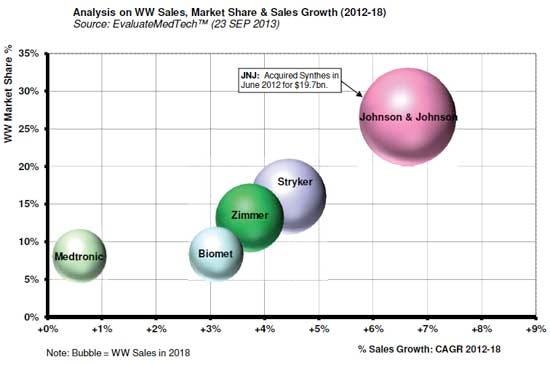Innovation in the estimated $32 billion orthopedics industry has largely been evolutionary, not revolutionary, according to medical device analyst Raj Denhoy of Jefferies & Company Inc. (New York City). Medical intervention hasn’t dramatically changed in the orthopedics sector, and as a result, analysts expect to see about 6% growth during the next five years.
May 26, 2010
 Innovation in the estimated $32 billion orthopedics industry has largely been evolutionary, not revolutionary, according to medical device analyst Raj Denhoy of Jefferies & Company Inc. (New York City). Medical intervention hasn’t dramatically changed in the orthopedics sector, and as a result, analysts expect to see about 6% growth during the next five years. Current clinical outcomes for existing implants are already good, so recent and future product introductions are only incrementally better. However, this isn’t bad news. There is still a great clinical need for orthopedic devices, and they’re the most successful medical interventions from a surgical standpoint, said Denhoy, who spoke at the OrthoTec conference in May.
Innovation in the estimated $32 billion orthopedics industry has largely been evolutionary, not revolutionary, according to medical device analyst Raj Denhoy of Jefferies & Company Inc. (New York City). Medical intervention hasn’t dramatically changed in the orthopedics sector, and as a result, analysts expect to see about 6% growth during the next five years. Current clinical outcomes for existing implants are already good, so recent and future product introductions are only incrementally better. However, this isn’t bad news. There is still a great clinical need for orthopedic devices, and they’re the most successful medical interventions from a surgical standpoint, said Denhoy, who spoke at the OrthoTec conference in May.
Underlying demographics, including an aging population, rising obesity rates, and increased fitness, are driving growth in this industry. This year, more than 40 million people will be over the age of 65. By 2030, this number will increase to more than 71 million, and by 2050, it will hit more than 87 million, said Denhoy. On the obesity front, more than half of the U.S. adult population is overweight and more than one-third are considered obese. And even those people who regularly engage in a high level of physical activity (about 20% of Americans) might require orthopedic devices to stay active. All of these factors contribute to the demand for orthopedic devices.
However, pricing pressures remain a concern as more power is slowly shifting from surgeons to hospitals, and this is only expected to get worse. This means surgeons will have less power over which devices they can use on patients. In addition, implants have become commodities, and there isn’t a lot of truly new technology coming down the pipeline. As Denhoy put it, the industry is “running to stand still.”
Even the once-hot spine market has cooled down. During last year’s fourth quarter, Medtronic and Zimmer Holdings reported negative growth (–1% and –15%, respectively) in their spine deivision. Synthes, Stryker, and Biomet all saw modest 6% growth, and Johnson & Johnson reported just 3% growth. However, NuVasive broke this mold with 43% growth. Despite the slower growth in spinal devices, this segment, along with extremities, has seen more innovation than others in orthopedics.
The final piece of the puzzle is healthcare reform, the effect of which remains to be seen. However, hospitals will be placed under increasing pressure, and manufacturers will face pricing issues. The outlook for this industry remains challenging, said Denhoy.
About the Author(s)
You May Also Like


